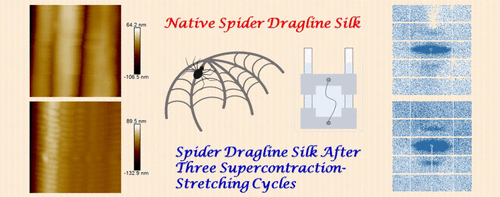当前位置:
X-MOL 学术
›
Biomacromolecules
›
论文详情
Our official English website, www.x-mol.net, welcomes your
feedback! (Note: you will need to create a separate account there.)
Structural Changes in Spider Dragline Silk after Repeated Supercontraction–Stretching Processes
Biomacromolecules ( IF 5.5 ) Pub Date : 2020-11-18 , DOI: 10.1021/acs.biomac.0c01378 Linli Hu 1 , Qianying Chen 1 , Jinrong Yao 1 , Zhengzhong Shao 1 , Xin Chen 1
Biomacromolecules ( IF 5.5 ) Pub Date : 2020-11-18 , DOI: 10.1021/acs.biomac.0c01378 Linli Hu 1 , Qianying Chen 1 , Jinrong Yao 1 , Zhengzhong Shao 1 , Xin Chen 1
Affiliation

|
Spider dragline silk is well-known for its excellent combination of strength and extensibility as well as another unique property called supercontraction. In our previous work, the changes in conformations of the Nephila edulis spider dragline silk when subjected to different supercontraction processes were extensively investigated. When a native spider dragline silk had free supercontraction, and then restretched to its original length, the content and molecular orientation of different conformations (β-sheet, helix, and random coil) changed but the mechanical properties remained almost the same. Therefore, herein, further supercontraction–stretching treatment was performed up to three cycles, and the corresponding structural changes were investigated. In addition to the synchrotron radiation FTIR (S-FTIR) microspectroscopy employed in our previous study, synchrotron radiation small-angle X-ray scattering (S-SAXS) and atomic force microscopy (AFM) were also used in this work to determine the structural changes of spider dragline silk in different scales. The results show that by repeating the supercontraction–stretching treatment, the β-sheet structure content in spider dragline silk was slightly increased, but its orientation degree remained almost the same. Also, with the increase in cycle of supercontraction–stretching treatments, a 10.5 nm long period perpendicular to the silk fiber axis gradually appeared, endowing the spider dragline silk with periodic structure both along (6.6 nm, already existed in native silk and did not change with the supercontraction–stretching treatment) and perpendicular to the silk fiber axis. After the third supercontraction–stretching cycle, the AFM images displayed a clear 210 nm × 80 nm corn kernel-like structure on the surface of nanofibrils in spider dragline silks, which may be related to the aggregation of 10.5 nm × 6.6 nm periodic structure observed via S-SAXS. Finally, although the structure of spider dragline silk became increasingly regular with the rise in supercontraction–stretching cycles, mechanical properties remained constant after every cycle of the supercontraction–stretching treatment. These findings can aid in further understanding the structural changes that are related to the supercontraction of spider dragline silk and provide useful guidance in fabrication of high-performance regenerated or artificial silk fibers.
中文翻译:

重复的超伸缩拉伸过程后蜘蛛拉铲丝的结构变化
蜘蛛式拉铲丝以其出色的强度和延展性以及另一个独特的超收缩特性而闻名。在我们之前的工作中,可食的Nephila构象的变化蜘蛛拉铲丝在经受不同的超收缩过程时被广泛研究。当天然蜘蛛牵引铲丝具有自由的超收缩力,然后再伸长至其原始长度时,不同构象(β-折叠,螺旋和无规卷曲)的含量和分子取向发生了变化,但机械性能几乎保持不变。因此,在本文中,进行了多达三个循环的进一步超收缩拉伸处理,并研究了相应的结构变化。除了在我们先前的研究中使用的同步辐射FTIR(S-FTIR)显微光谱学之外,这项工作中还使用了同步辐射小角度X射线散射(S-SAXS)和原子力显微镜(AFM)来确定结构蜘蛛牵引丝的不同尺度变化。结果表明,通过重复超收缩拉伸处理,蜘蛛式拉铲丝的β-片层结构含量略有增加,但其取向度几乎保持不变。另外,随着超拉伸-拉伸处理周期的增加,垂直于丝纤维轴的10.5 nm长周期逐渐出现,赋予蜘蛛牵引线蚕丝具有周期性结构(6.6 nm,已存在于天然丝中并且没有改变)经过超收缩拉伸处理)并垂直于丝纤维轴。在第三个超收缩-拉伸循环后,AFM图像在蜘蛛拉铲丝中的纳米原纤维表面显示出清晰的210 nm×80 nm玉米核样结构,这可能与10.5 nm×6的聚集有关。通过S-SAXS观察到6 nm周期性结构。最后,尽管随着超伸缩拉伸周期的增加,蜘蛛式拉铲丝的结构变得越来越规则,但在每个超伸缩拉伸处理周期之后,力学性能仍保持恒定。这些发现可以帮助进一步理解与蜘蛛拉铲丝的超收缩有关的结构变化,并为高性能再生或人造丝纤维的制造提供有用的指导。
更新日期:2020-12-14
中文翻译:

重复的超伸缩拉伸过程后蜘蛛拉铲丝的结构变化
蜘蛛式拉铲丝以其出色的强度和延展性以及另一个独特的超收缩特性而闻名。在我们之前的工作中,可食的Nephila构象的变化蜘蛛拉铲丝在经受不同的超收缩过程时被广泛研究。当天然蜘蛛牵引铲丝具有自由的超收缩力,然后再伸长至其原始长度时,不同构象(β-折叠,螺旋和无规卷曲)的含量和分子取向发生了变化,但机械性能几乎保持不变。因此,在本文中,进行了多达三个循环的进一步超收缩拉伸处理,并研究了相应的结构变化。除了在我们先前的研究中使用的同步辐射FTIR(S-FTIR)显微光谱学之外,这项工作中还使用了同步辐射小角度X射线散射(S-SAXS)和原子力显微镜(AFM)来确定结构蜘蛛牵引丝的不同尺度变化。结果表明,通过重复超收缩拉伸处理,蜘蛛式拉铲丝的β-片层结构含量略有增加,但其取向度几乎保持不变。另外,随着超拉伸-拉伸处理周期的增加,垂直于丝纤维轴的10.5 nm长周期逐渐出现,赋予蜘蛛牵引线蚕丝具有周期性结构(6.6 nm,已存在于天然丝中并且没有改变)经过超收缩拉伸处理)并垂直于丝纤维轴。在第三个超收缩-拉伸循环后,AFM图像在蜘蛛拉铲丝中的纳米原纤维表面显示出清晰的210 nm×80 nm玉米核样结构,这可能与10.5 nm×6的聚集有关。通过S-SAXS观察到6 nm周期性结构。最后,尽管随着超伸缩拉伸周期的增加,蜘蛛式拉铲丝的结构变得越来越规则,但在每个超伸缩拉伸处理周期之后,力学性能仍保持恒定。这些发现可以帮助进一步理解与蜘蛛拉铲丝的超收缩有关的结构变化,并为高性能再生或人造丝纤维的制造提供有用的指导。











































 京公网安备 11010802027423号
京公网安备 11010802027423号